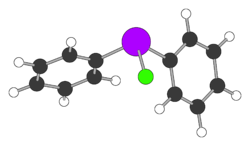Diphenylchlorarsine

| |

| |
| Names | |
|---|---|
| Preferred IUPAC name
Diphenylarsinous chloride | |
| Other names
diphenylchlorarsine, diphenylchloroarsenic, chlorodiphenylarsane, sneezing gas
| |
| Identifiers | |
3D model (
JSmol ) |
|
| Abbreviations | Ph2AsCl |
| ChemSpider | |
ECHA InfoCard
|
100.010.839 |
PubChem CID
|
|
| UNII | |
CompTox Dashboard (EPA)
|
|
| |
| |
| Properties | |
| C12H10AsCl | |
| Molar mass | 264.59 g mol−1 |
| Appearance | colorless crystalline solid |
| Density | 1.55 g/cm3 |
| Melting point | 42 °C (108 °F; 315 K) |
| Boiling point | 307.2 °C (585.0 °F; 580.3 K) |
| -145.5·10−6 cm3/mol | |
Except where otherwise noted, data are given for materials in their standard state (at 25 °C [77 °F], 100 kPa).
| |
Diphenylchloroarsine (DA) is the
Preparation and structure
It was first produced in 1878 by the German chemists August Michaelis (1847–1916) and Wilhelm La Coste (1854–1885).[1][2] It is prepared by the reduction of diphenylarsinic acid with sulfur dioxide. An idealized equation is shown:[3]
- Ph2AsO2H + SO2 + HCl → Ph2AsCl + H2SO4
The process adopted by Edgewood Arsenal, the "sodium process", for the production of DA for chemical warfare purposes, employed a reaction between chlorobenzene and arsenic trichloride in the presence of sodium.[4][5]
The German process, used in the first war, applied at Hochstam-Main, used the
The structure consists of pyramidal As centre. The As-Cl distance is 2.26 A and the Cl-As-C and C-As-C angles are 96 and 105°, respectively.[6]
Uses
It is a useful reagent for the preparation of other diphenylarsenic compounds, e.g. by reactions with Grignard reagents:
- RMgBr + (C6H5)2AsCl → (C6H5)2AsR + MgBrCl
- (R = aryl)
Chemical warfare
Diphenylchlorarsine was used as a chemical weapon on the Western front during the trench warfare of World War I.[7] It belongs to the class of chemicals classified as vomiting agents. Other such agents are diphenylcyanoarsine (DC) and diphenylaminechlorarsine (DM, Adamsite).[8] Diphenylchlorarsine was sometimes believed to penetrate the gas masks of the time and to cause violent sneezing, forcing removal of the protecting device. The Germans called it Maskenbrecher (mask breaker), together with other substances with similar effects, such as Adamsite, diphenylarsincyanide, and diphenylaminarsincyanide.[citation needed] This gas did not actually penetrate masks any better than other gases.[9]
DA (military code and acronym for diphenylchloroarsine) is a precursor to DC (diphenylcyanoarsine), generated by the reaction of an aqueous solution of sodium cyanide and DA (DC process, NaCN method), with cyanide being used in excess of 5%, for military purposes.[5]
Toxicity
Diphenylchlorarsine is known to cause
See also
References
- . From p. 1317: "Der zweite neben Phenylarsenchlorid gebildete weisse Körper ist noch nicht untersucht, er ist wahrscheinlich Diphenylarsenchlorid, … " (The second white substance that formed beside phenylarsenic chloride has still not been investigated, it's probably diphenylarsenic chloride, … ) In 1878, Michaelis confirmed that it was indeed diphenylarsenic chloride.(La Coste & Michaelis, 1878), p. 1885
- . See Diphenylarsenchlorür on p. 1885.
- .
- ^ An Historical Sketch of Edgewood Arsenal. p 66
- ^ a b c CHEMICAL CORPS CHEMICAL AND RADIOLOGICAL LABORATORIES. Army Chemical Center Maryland. Project: 4-72-05-005. 25 October, 1954
- doi:10.1139/v62-241.
- ISBN 0805047344.
- ^ Holstege, C. P.; Boyle, J. S. (2008-11-26). "CBRNE - Vomiting Agents - Dm, Da, Dc". Medscape.
- ^ Gas and Flame in Modern Warfare, 1918, Chapter IX.
- ^ "Abandoned Chemical Weapons (ACW) in China". February 6, 2004. Archived from the original on July 4, 2008.
